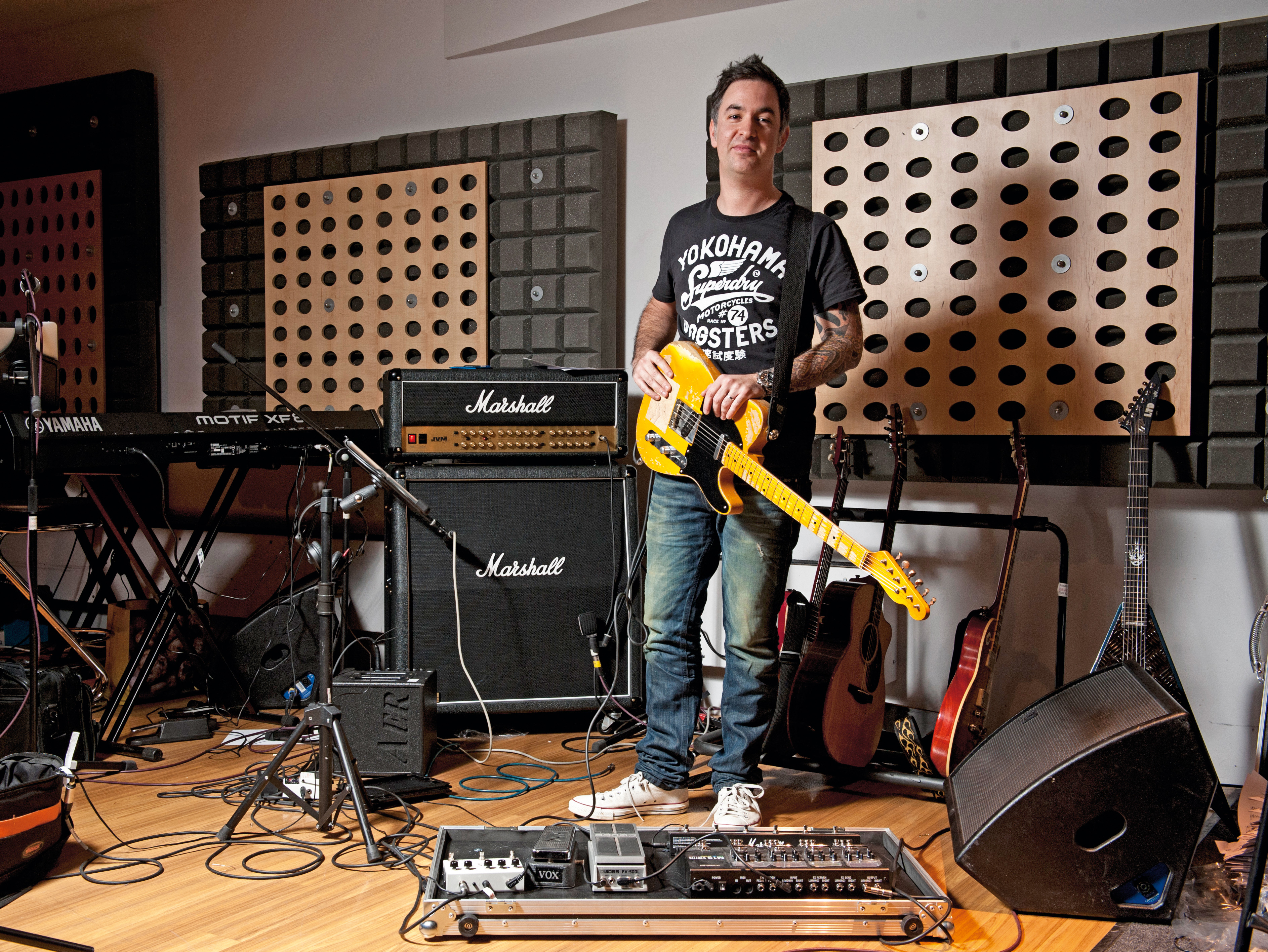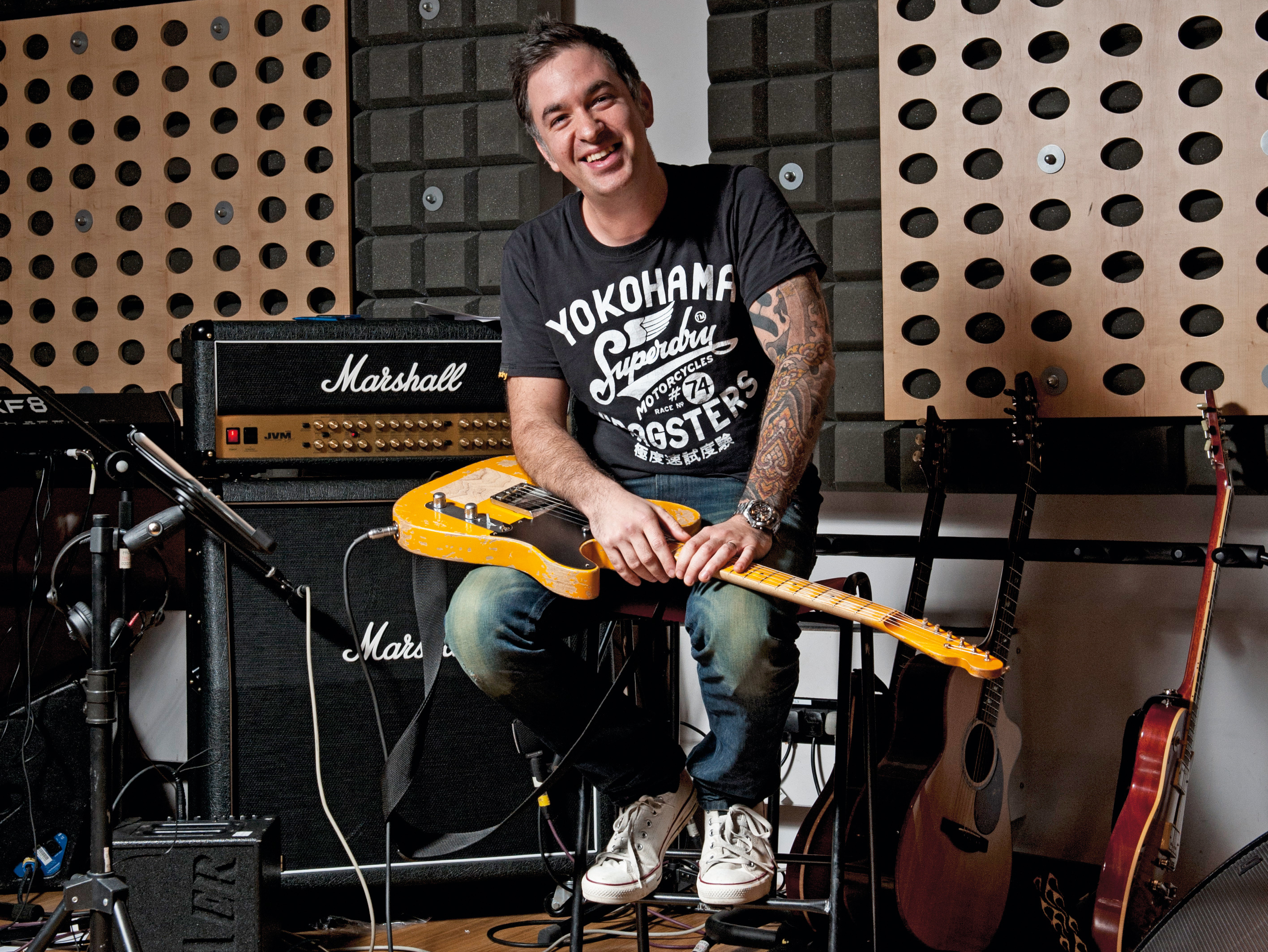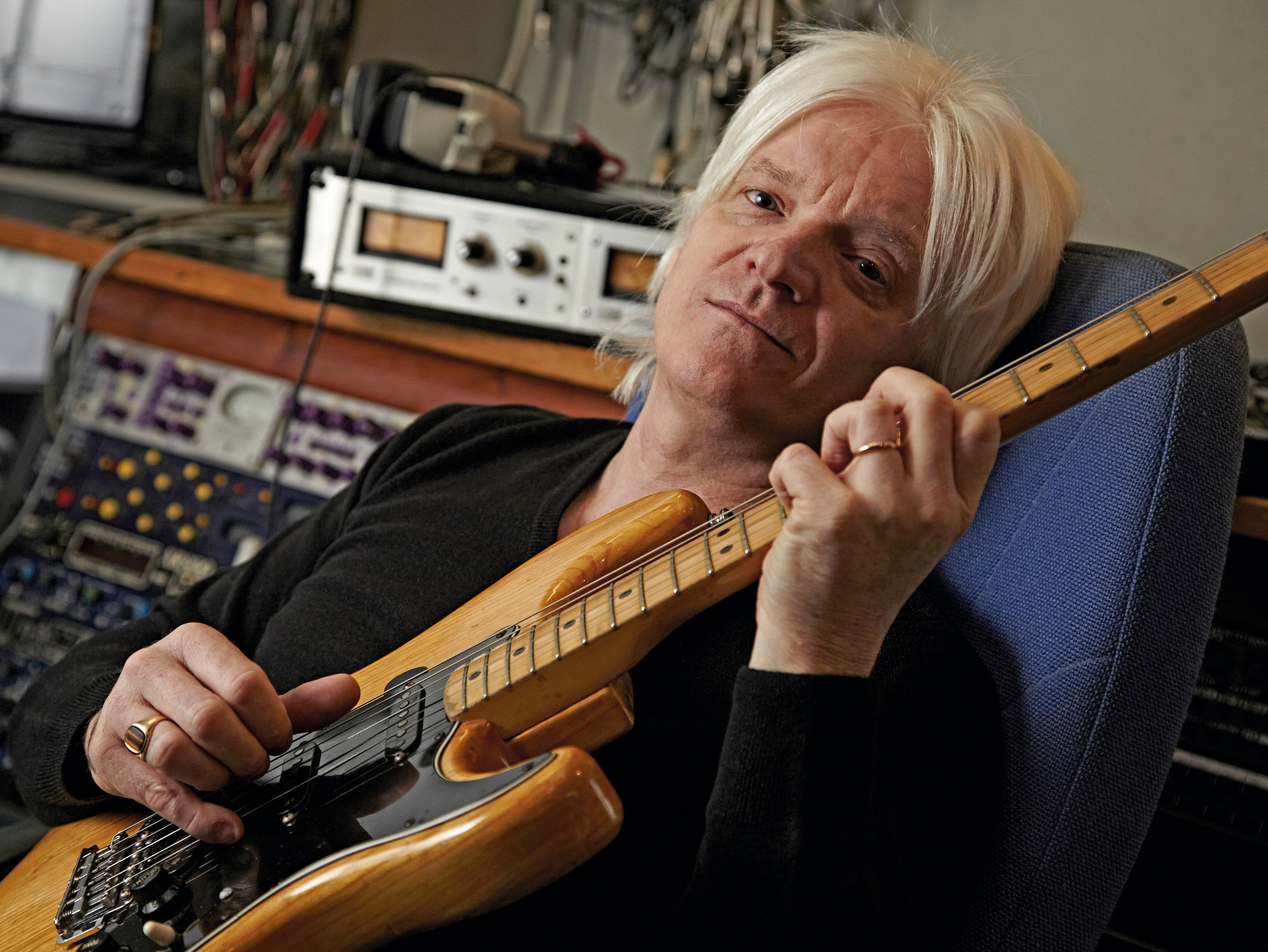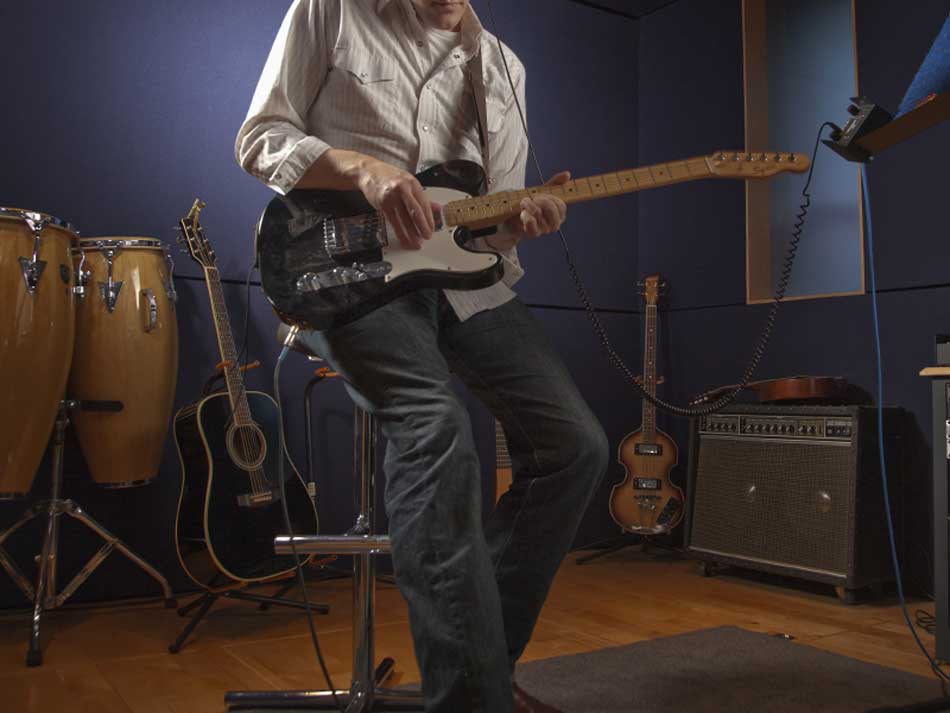How to make it as a session guitarist
Want to make a living out of your playing? This could be the way...

Meet Adam Goldsmith (The Voice, Strictly Come Dancing)
Let's face it, being a session guitarist is probably the best job in the world. You play guitar for a generous fee in top studios and riff on stage with superstars before a packed stadium crowd. But when the music's over you can walk past the ranks of paparazzi with nary a flashbulb popping. What's not to like?
Well, as we learned from two of the country's top session pros, it's not quite as simple as that. Adam Goldsmith, who plays guitar on the BBC's hit television show The Voice, and Neil Taylor, who has played sessions for artists such as Robbie Williams and Tina Turner, gave Guitarist the inside story of what it's like to work at the sharp end of the session scene.
They reveal how varied the job of a session guitarist can be. Do you want to be a creative collaborator, who crafts global hits alongside the biggest names in music? Or a razor-sharp virtuoso who can nail the perfect solo in minutes flat?
Ideally, you'll be a bit of both. Read on to find out what it takes to be a session pro: from selecting the right amps, effects and guitars to the skills you'll need to pay the bills...
Adam Goldsmith
If you think you've got a lot to get through at your band's next practice, spare a thought for Adam Goldsmith, the session guitarist hired to join the elite house band backing contestants on the BBC talent show The Voice.
Fancy learning 50 songs a day? Such is Adam Goldsmith's lot as guitarist for The Voice. "It's a ridiculous schedule!" he admits. "We've done three or four days with just the band, and today's the last day. Then from tomorrow on, all the contestants come in. They get half an hour each with us, and we're working 10am until 10pm, 12-hour days. So there's no sort of rock 'n' roll behaviour – it's just completely down to business."
Despite the frantic pace of work, Adam loves his job and has become adept at going from first rehearsal to live performance in a breathtakingly short interval.
"The tricky thing about my kind of job is that you don't get very much notice about anything you're doing. For example, when I've done Strictly Come Dancing you get to play the songs through once, and then you're on TV."
"When I've done Strictly Come Dancing you get to play the songs through once, and then you're on TV"
"It's going to be the same with these guys," he says of the contestants due to join him and the band the next day. "We get half an hour with each of them, which is quite a lot actually. But within that half an hour they may want to change the whole key of a song for example. Sometimes doing things in different keys just doesn't work on guitar, but that's my problem – no one else cares! So you have to find quick fixes, re-tuning, all sorts of stuff. And you have to do it 'now'. That's the tough thing."
Mr Versatility
We asked him how he developed his versatility to such an impressive degree. "Getting things wrong! If you get things wrong enough, then eventually you get them right. When I was seven I started classical piano, so I had a background in reading, music theory and that stuff, and I went to the Royal Academy Of Music as well, so that kind of helps. But really how I learned was playing along to records, such as [Metallica's] ...And Justice For All."
Adam was lucky – and talented – enough to get his first break straight after university, dropping in not so much at the deep end as the middle of the Atlantic.
"I did the first Pop Idol tour and that was pretty much straight out of college. I remember turning up and the first gig we did was Wembley, so that was a huge moment. But once you've done one gig, I guess it's like any industry. If you don't f**k it up, somebody will ask you to do another one."

Gear and war stories
Stairway to success
"I'll give you a good example: I did a rock concert with the Royal Philharmonic Orchestra. They had their orchestra and a rhythm section, you got three hours' rehearsal time, and then you had to play songs such as Bohemian Rhapsody, Stairway To Heaven and Layla – but you only got to go through them once. Everyone can play Stairway To Heaven, but until you've tried playing it in front of 6,000 people on your own, with an orchestra, wearing a dinner jacket... then you find that it can be hard!"
We ask Adam if nerves don't occasionally get the better of him in such situations, but he says that it's second nature to channel nervous energy into his performance.
"Everyone gets nervous: you aren't human if you don't get nervous. But I'm pretty lucky, because the more nerves I have the more focused I become. That's just an accident. You don't practise getting nerves, it's just something that happens. So it's a complete stroke of luck that nerves tend to make me better and more focused rather than the other way around."
Average schmaverage
With the chops and the temperament to tackle anything that comes his way, we ask Adam what sort of jobs he'll face on an average working week.
"There isn't really one, to be honest," he replies. "It could be anything. This time last year I had just come back from a world tour with [classical crossover singer] Katherine Jenkins. That said, this month is fairly typical, I guess. The Voice is taking up most of it, but I'm also doing pre-records for a new series of Upstairs Downstairs. The music is written by a guy called Carl Davis, who is quite a famous composer, so that's a lot of classical guitar. I also did a BUPA advert a little while ago. It's not very rock 'n' roll!"
With so much musical ground to cover, Adam says it's wise to acquire a number of reliable amps, guitars and effects to ensure that you never get caught out.
"If it was a studio session where I didn't know what I was going to be playing, then I would take a small combo amp. I've got a Dr Z and a Cornford and I use them a lot. Fairly low wattage is a good idea in the studio. But on The Voice I'm using a Marshall half stack, because there's people to move it around for me, basically!
Gear
"Guitar-wise, there's a Squier Pro Tone Strat that I usually take, and I tend to bring my Les Paul as well, so I've got one humbucking guitar and one Strat-type guitar. If a producer wants something special they'll let you know beforehand: if they say it's definitely a country session, then you know you have to take your Tele and a Fender amp.
"But if there's all kinds of music to tackle then it's different. I did the last series of Stars In Their Eyes and for that kind of situation you have something like TC Electronic's G System to cover everything, plus a good-sounding amp and a bunch of pedals. And you just have to take loads of guitars, basically.
"The most important things are boring, really," he says, "such as making sure your guitars are set-up properly so everything's exactly in tune"
"I've got a '59 VOS Les Paul, which I always take – that's a great-sounding guitar – and a PRS that I often bring as well. I use D'Addario 0.010s for everything except jazz."
In terms of skills, Adam says that in his line of work being able to sight-read fluently is a must, while your gear has to be kept in top fettle at all times.
"The most important things are boring, really," he says, "such as making sure your guitars are set-up properly so everything's exactly in tune. You need to make sure you don't have any crackling leads and that you've got spare valves for your amp and so on. Because the last thing you want to do is hold up a session. You need to be good now and not get in anyone's way."

Neil Taylor (Tears For Fears, Morrissey, Tina Turner, Robbie Williams)
If Adam Goldsmith represents one side of the session coin, Neil Taylor is the other. It's his knack for working closely with artists to come up with hit-making hooks and riffs that has kept him employed at the top of the music industry
As well as being Robbie Williams' regular sideman in the studio and on tour, Neil Taylor has also played sessions with artists such as Tina Turner, Morrissey and eighties pop giants Tears For Fears.
It was Tears For Fears who got Neil's session career started after their 1983 debut album The Hurting broke into the charts and the band realised they needed a guitarist to join them on stage, Neil recalls.
"I bumped into Curt Smith at a party and he said, Oh God, we've been trying to find you. I said, Really? Why? He said, Well we're doing a tour and we want you to play guitar for us. So, we did a small English tour and then I was asked to join them in the studio to work on Songs From The Big Chair."
15-minute breakthrough
Helpfully, one of the first solos Neil cut with the band was for their hit single Everybody Wants To Rule The World, which has been played on radio more than two million times since then.
"I just started playing and I did it in two takes," Neil recalls. "That was one of my first proper sessions and I was there for like 15 minutes when they said, You've done it. I invoiced a bit later on and I got £200 for it. I couldn't believe that I'd made £200 for 15 minutes' work!"
Having made a name with Tears For Fears, the sessions started rolling in, he says.
"Then I got a call to do some work with Alison Moyet back in 1987 and I thought to myself, It's quite good money, I'll do that for a while. And then I just fell into doing sessions and they just carried on from there, you know."

Writing in sessions and the changing nature of session work
"The kind of work that I was picking up, it wasn't because of my technical chops really," he adds. "It was because of what I could add to a record. People might say, Let's get Neil in, because he's good at this, or that, or whatever: basically being creative."
While Neil cautions that "there's not as much work like that anymore," it's still important for him to be able to help shape the vibe of a track when he's on a session.
"It's great when you walk into a studio and the producer plays the song and says, What can you hear on this? And you'll start noodling around and then maybe they'll say, Yes, great, I really like that, and then you build it together and create your guitar part."
"But it seems to be much more cut-and-dried these days," he adds, "and of course times have changed since the 1980s when you could almost command your own price. People are doing stuff for almost nothing these days."
Slick and creative
Fortunately, Neil's slick playing and his creative drive have kept him employed with some of the biggest acts in the world, and he has enjoyed a long working relationship with Robbie Williams. He first got the gig after recording with Chris de Burgh. A programmer working on the same project recommended Neil to Williams' ace songwriting partner Guy Chambers.
"The next thing I knew, I had a call from Guy Chambers," Neil recalls, "and I'd actually worked with his assistant producer and engineer, Steve Power, on previous sessions. So, that was my 'in' really.
"Guy got me up to the studio and the first thing I played on was the solo on Rock DJ. Then I got asked back to do the Escapology album. We did the album in LA with Guy and that's when I met Rob properly. He asked me if I wanted to be in his band and I thought, This is amazing.
"It went from there, really. Like I said, it's a great guitar player's gig because you can really get your teeth into it. There is a song, Come Undone, and when we've played that in the past I would go out into the crowd with Robbie. It's every guitar player's dream, isn't it? Playing in front of 80,000 people doing a massive guitar solo – and doing that every night for a year."
Despite getting offers of work from all quarters of the industry these days, Neil says the most important thing for him is to be able to work on material that he has an instinctive feel for.
"I've had phone calls before asking me to do certain things when I could have really done with the money," Neil says. "But I always turned those jobs down if they just weren't for me and I couldn't bring myself to do them. That's when it almost becomes like an ordinary job to me. I got into session guitar to avoid having to do that kind of thing."
Marshall man
Gear-wise, Neil relies on a small but road-proven selection of guitars (see box, left) and he uses a variety of Marshall amps for most jobs – although for many years he went with his faithful Mesa/Boogie Mark III.
"I've still got it and it's still great," he adds. "I also had a Yamaha SPX90 [rackmount multi-effects unit] when they were all the rage back in the late 1980s."
These days Neil favours the convenience of digital modelling effects, however.
"I've got the Line 6 stuff," he says. "I've got the [DL-4] delay and the [DM-4] distortion because sometimes people like those synthetic distortion sounds. That does so many different distortions, which is great, and I've got the [FM-4] modulator with chorus and all that kind of stuff."
"In terms of playing, it's all about being simple. There is no point in riffing over everything. They don't want that"
But clearly it takes a lot more than versatile guitar gear to make it on the session scene. What key qualities does Neil believe aspiring session aces need to have?
"In terms of playing, it's all about being simple. There is no point in riffing over everything. They don't want that. As soon as you walk in you just get a vibe and you know what's right and what's wrong – and that's part of your job, isn't it?
"Getting on with people is also a very important thing and so is being able to play in time. I used to played along with a Dr Rhythm, which was one of the first drum machines, and just practised playing in time. That really helped."

So you want to be a session player?
Talking to tried and trusted pros such as Adam Goldsmith and Neil Taylor hasn't changed our opinion that being a session guitarist is a plum job.
The good news is that creativity is still as sought- after as pristine licks. But if you think you might be good enough to cut it on the session scene, remember that you won't get far if you can't do the following...
1. Be versatile
In the kind of rapid- fire work that Adam Goldsmith does, you'll also need to be a fluent sight-reader so you can run through material with a pro band within seconds of plugging in.
2. Be reliable
The message is clear: if you turn up on time and do the job well you'll get more work. Hold everyone up with fumbled playing or dodgy gear and the phone will stop ringing. You'll need to carry spares so kit failure can be resolved on the spot, and the show can go on.
3. Be easy to work with
The music industry is a very sociable business. Getting on with the artists and producers you work with means that they'll be more comfortable offering you work on a long tour – while a friendly, professional attitude will inspire trust on shorter jobs.
4. Be tooled up
Because session guitarists cover so much musical ground, you'll need a few options to hand in terms of high-quality guitars, amps and effects.
It's worth noting, though, that both Adam and Neil have relatively inexpensive guitars that get used as often as their boutique gear. The main thing is that each guitar is comfortable to use and is set up perfectly to deliver classic tones, both in the studio and on stage.
Guitarist is the longest established UK guitar magazine, offering gear reviews, artist interviews, techniques lessons and loads more, in print, on tablet and on smartphones
Digital: http://bit.ly/GuitaristiOS
If you love guitars, you'll love Guitarist. Find us in print, on Newsstand for iPad, iPhone and other digital readers
